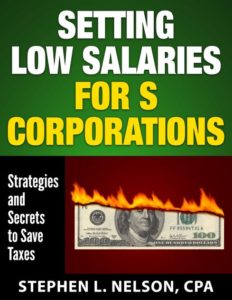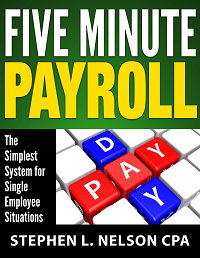 One of the challenges of setting a reasonable compensation amount for shareholder-employees of an S corporation is that no official “safe harbor” exists.
One of the challenges of setting a reasonable compensation amount for shareholder-employees of an S corporation is that no official “safe harbor” exists.
Well, none exists other than simply calling all your business profit “wages”…
But that doesn’t stop people—especially high income S corporation owners—from wanting to have a safe harbor.
In this short post, then, I provide a handful of salary levels you can maybe think about as “safe harbors”…
The Buffet Rule
Warren Buffett is famous for many reasons, including his suggestion that the super-rich should pay a minimum amount of tax.
If you’re an S corporation shareholder-employee, however, it would appear that you can also look at some of Mr. Buffet’s recent year salary amounts for a rule people seem to think is an okay salary for an entrepreneur.
As reported by CBS, Mr Buffet said in 2010 that he pays $15,300 in payroll taxes. Because the payroll tax rate is 15.3%, that $15,300 of taxes suggests Buffet earns or earned a $100,000 salary level. And that might be a reasonable salary for you, too.
Note: Inflation has pushed up wage levels since 2010, the year Mr. Buffet paid this payroll tax burden. But he’s also running a giant global conglomerate. And you (and I) aren’t…
The FICA Maximum
Another unofficial safe harbor you may want to consider? The FICA limit, which is $137,700 in 2020.
Some and maybe even most tax people think that setting your salary level to the FICA maximum works as a safe harbor. Why? Because it allows the IRS to collect the maximum amount of Social Security taxes from employee and employer.
As reported in my ebook on setting S corporation salaries, I’ve heard an Internal Revenue Service S corporation expert state in a large public tax practitioner forum that the FICA limit provides enough shareholder-employee compensation to be almost automatically considered “reasonable.”
Note: If you make so much money in your S corporation that using the FICA limit sounds too low, keep in mind that in addition to a $137,700 salary, you presumably also enjoy additional tax-free fringe benefits. Those benefits further increase your compensation and figure into its reasonableness. Health insurance and an employer pension, for example, might add tens of thousands of dollars of compensation.
The 401(k) Plan Optima
One final idea. Maybe you set your salary to the amount that lets you maximize your 401(k) contribution.
This requires you to do a bit of math. But for 2020, for example, you can contribute up to $19,500 to a 401(k) plan (or up to $26,000 if you’re age 50 or older)
Further, the employer part of the pension can equal 25% of your wages.
Finally, the total amount that goes into your 401(k) can’t be more than $57,000 if you’re younger than age 50 and more than $63,500 if you’re age 50 or older.
Combine these rules and work through the math and you might decide to set your wages to $150,000.
At $150,000 of wages, you can make a $37,500 employer match pension fund contribution. (This $37,500 value equals 25% of the $150,000 salary.)
And then if you are younger than age 50, you could add the $19,500 of elective deferral—the employee part—to get all the way to $57,000.
Or if you’re 50 or older, you could add the $26,000 of elective deferral to the $37,500 and get all the way to $63,500.
That $187,500 combination of wages and pension match gives you a pretty dang high salary and one that should survive most challenges of “unreasonable compensation.”
Note: Okay, we’re’ talking safe harbors here, but I am compelled to point out that bumping your salary so you can bump your pension contribution probably doesn’t save you taxes. Yes, it maximizes your pension deduction. Absolutely. But most likely it doesn’t once you consider all the costs save you money. (You can check out this post if you want the gritty details of my argument.)
Two Downloadable eBooks You Might Find Interesting
Because we’re on the subject of S corporation shareholder payroll, let me mention something. People regularly email or call and ask about how to set a reasonable yet low S corporation salary. And about how to do payroll for a single employee situation easily and cheaply.
Accordingly, we’ve published a couple of economical e-books.
Completely updated for 2019, the Five Minute Payroll e-book explains how to do simple cookie-cutter payroll for most one-employee S Corporations. The trick, by the way? Simple. Using base salary amounts of $10,000 a quarter or $16,000 a quarter. (These amounts mean annual compensation levels of $40,000 or $64,000 for a shareholder employee.)
The Five Minute Payroll e-book includes sample IRS forms you can copy. Furthermore, the e-book provides some common-sensed tips you can use to set a reasonable salary for your S corporation.
If you’re interested in buying and then downloading this $20 e-book—which should mean you don’t need to use a third-party payroll service—click this button:
Written in plain, everyday language, our Setting Low Salaries of S Corporations e-book explains how to save thousands of dollars a year with your S corporation. But in a manner that lets you follow the rules. And in a manner that minimizes the chance your S corporation salary will be rejected by the Internal Revenue Service.
 Priced at $50, this e-book should save you thousands of dollars a year in payroll taxes. To buy and download the S corporation salaries e-book, click this button:
Priced at $50, this e-book should save you thousands of dollars a year in payroll taxes. To buy and download the S corporation salaries e-book, click this button:
Click for more info or to purchase and download
A final comment. All of our monographs and ebooks come with a money back guarantee.
